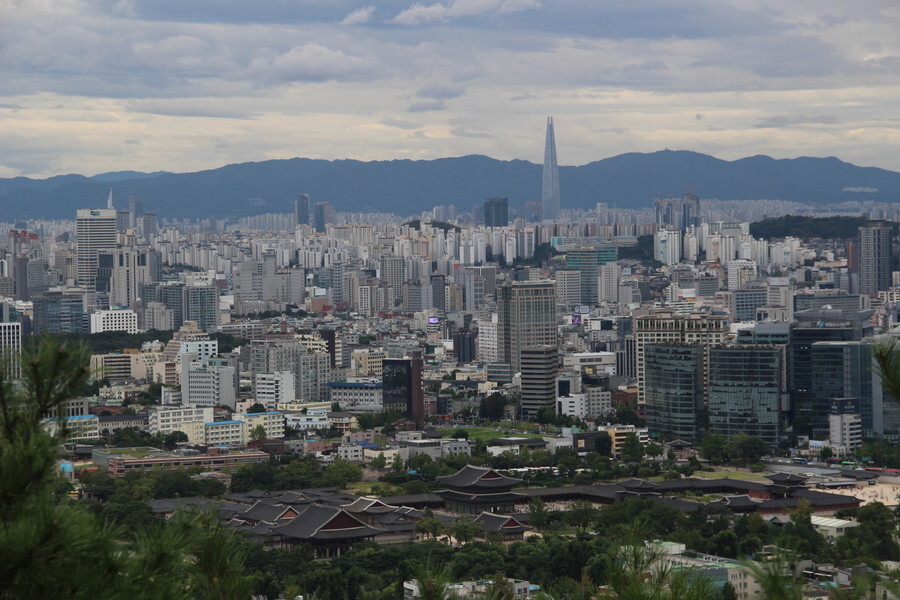hankyoreh
Links to other country sites 다른 나라 사이트 링크
Greater Seoul population exceeds 50% of S. Korea for first time

For the first time in the history of South Korea, the population of the greater Seoul area, or the Seoul Capital Area (SCA), has exceeded 50% of the country’s total population. Experts say that the concentration of wealth, power, and people in the capital, a phenomenon that has been in place since the country’s industrialization, has now reached an extreme. Civic groups are calling on the government to come up with a plan for balanced development and to establish a powerful body to implement that plan.
According to citizen registration data accessed through the Korean Statistical Information Service (KOSIS) on Jan. 6, 25,925,799 South Korean citizens, or 50.002% of the total population of 51,849,861, are living in the SCA (which includes Seoul, Gyeonggi Province and Incheon) as of the end of December 2019. That was 1,737 more than the 25,924,062 citizens (49.998% of the population) who live in Korea’s other 14 metropolitan cities and provinces. This was the first time on record that the population of the capital region exceeded that of the rest of the country.
The SCA population comprises 9,729,107 people living in Seoul, 13,239,666 in Gyeonggi Province, and 2,957,026 in Incheon. The population of Seoul proper exploded after the Korean War until 1992 and has been steadily declining since.
But the SCA population as a whole has continued rising amid large increases in the populations of Gyeonggi and Incheon. This is being attributed to the population of Seoul spilling over into the Gyeonggi and Incheon areas rather than shrinking as such.
As of 1970, the SCA accounted for around 28.7% of South Korea’s population. In the 50 years since then, that number has risen by 21.3 percentage points -- from 35.5% in 1980 to 42.8% in 1990, 46.3% in 2000, 49.2% in 2010, and 50% in 2019. While the SCA’s proportion of the population has risen steadily since 2000, it remained briefly stagnant between 2011 and 2015 as more residents arrived in Sejong and innovation cities amid efforts by the Roh Moo-hyun administration. But with a lack of follow-up policies to promote balanced development, the percentage began rising again in 2016 to pass the 50% mark.
In a statement published on Jan. 5, the National Forum for Balanced Development, an association of civic groups, said, “We view this unprecedented development in the history of the Republic of Korea as a very serious national emergency.”
“The Moon Jae-in administration needs to establish strong and comprehensive countermeasures at the pan-governmental level and create a unified implementation system with the executive ability to pursue balanced development and decentralization,” it urged.
“Hopefully, such ideas will be reflected in President Moon Jae-in’s scheduled New Year’s address on Jan. 7,” it added.
By Kim Kyu-won, senior staff writer
Please direct comments or questions to [english@hani.co.kr]

Editorial・opinion
![[Column] Season 2 of special prosecutor probe may be coming to Korea soon [Column] Season 2 of special prosecutor probe may be coming to Korea soon](https://flexible.img.hani.co.kr/flexible/normal/500/300/imgdb/original/2024/0426/3317141030699447.jpg) [Column] Season 2 of special prosecutor probe may be coming to Korea soon
[Column] Season 2 of special prosecutor probe may be coming to Korea soon![[Column] Park Geun-hye déjà vu in Yoon Suk-yeol [Column] Park Geun-hye déjà vu in Yoon Suk-yeol](https://flexible.img.hani.co.kr/flexible/normal/500/300/imgdb/original/2024/0424/651713945113788.jpg) [Column] Park Geun-hye déjà vu in Yoon Suk-yeol
[Column] Park Geun-hye déjà vu in Yoon Suk-yeol- [Editorial] New weight of N. Korea’s nuclear threats makes dialogue all the more urgent
- [Guest essay] The real reason Korea’s new right wants to dub Rhee a founding father
- [Column] ‘Choson’: Is it time we start referring to N. Korea in its own terms?
- [Editorial] Japan’s rewriting of history with Korea has gone too far
- [Column] The president’s questionable capacity for dialogue
- [Column] Are chaebol firms just pizza pies for families to divvy up as they please?
- [Column] Has Korea, too, crossed the Rubicon on China?
- [Correspondent’s column] In Japan’s alliance with US, echoes of its past alliances with UK
Most viewed articles
- 1[Column] Season 2 of special prosecutor probe may be coming to Korea soon
- 2No good, very bad game for Korea puts it out of Olympics for first time since 1988
- 3‘We must say no’: Seoul defense chief on Korean, USFK involvement in hypothetical Taiwan crisis
- 4Division commander ordered troops to enter raging flood waters before Marine died, survivor says
- 5Is Japan about to snatch control of Line messenger from Korea’s Naver?
- 6Korea’s 1.3% growth in Q1 signals ‘textbook’ return to growth, says government
- 7Is N. Korea threatening to test nukes in response to possible new US-led sanctions body?
- 8[Editorial] Korea’s surprise Q1 growth requires objective assessment, not blind fanfare
- 9[Editorial] New weight of N. Korea’s nuclear threats makes dialogue all the more urgent
- 10[Editorial] In the year since the Sewol, our national community has drowned